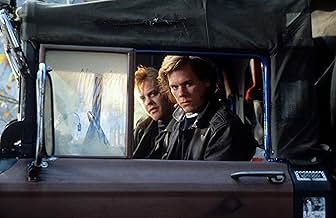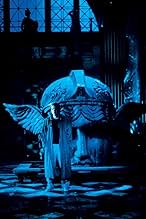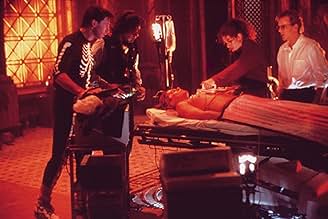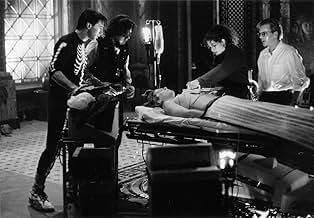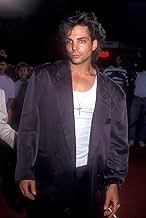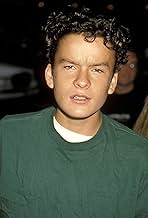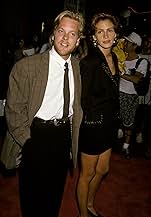Cinco estudantes de medicina experimentam experiências de quase morte, até que as consequências sombrias das tragédias passadas começam a pôr em risco suas vidas.Cinco estudantes de medicina experimentam experiências de quase morte, até que as consequências sombrias das tragédias passadas começam a pôr em risco suas vidas.Cinco estudantes de medicina experimentam experiências de quase morte, até que as consequências sombrias das tragédias passadas começam a pôr em risco suas vidas.
- Indicado a 1 Oscar
- 3 indicações no total
John Duda
- Young Labraccio
- (as John Joseph Duda)
Enredo
Você sabia?
- CuriosidadesJulia Roberts (Dr. Rachel Mannus) and Kiefer Sutherland (Nelson Wright) started dating during filming. They ended up engaged, but Roberts ultimately broke it off. She later married Lyle Lovett.
- Erros de gravaçãoWhile a defibrillator is of no use if a patient has truly flatlined, a patient in a "fine v-fib" rhythm can appear to have flatlined but still be revived with the paddles. Therefore, when in doubt, the Advanced Cardiac Life Support guidelines call for administering the shock, though it's not the treatment of choice.
- Citações
[first lines]
Nelson Wright: Today is a good day to die.
- Trilhas sonorasPARTY TOWN
Written and Performed by David A. Stewart (as Dave Stewart)
Courtesy of BMG Records (UK) Ltd.
Avaliação em destaque
A medical student named Nelson (Kiefer Sutherland) hatches a plan to explore death by briefly killing himself in a controlled environment then having his friends bring him back to life minutes later. Four fellow students join in the plan, taking turns with their explorations, competing with one another to see who can stay "under" the longest. What will the consequences of this dangerous game be? Without a doubt, the premise of Flatliners is intriguing. I can't speak for the medical veracity of the idea--I'm sure it's ridiculous--but it doesn't need to be realistic to provide fodder for a good film. Unfortunately, this isn't a good film. It's not quite failure, but it's damn close. It's as if somewhere along the line the film was brought back from the dead, but with severe brain damage.
One of the primary problems that director Joel Schumacher does not overcome is that these actors just do not seem like medical students, and the setting just doesn't seem like a medical school. In addition to Sutherland, the other "students" are Julia Roberts, Kevin Bacon, William Baldwin and Oliver Platt. With the exception of Platt, the other four seem more like models who got lost on their way back from a Vogue shoot. Platt seems like an overacting fussbudget who got lost on his way to a Steven Spielberg set. Writer Peter Filardi gives them more model-like dialogue, except when they're flatly reciting the medical terms they've memorized.
The "school", for some bizarre reason, is an old church/monastery, filled with Gothic statuary and modern construction accoutrements, such as scaffolding and those thick, transparent plastic sheets they hang in doorways. It does look cool, but it's difficult to buy the set as a medical school.
That might not usually be a problem for me--I love absurdism, after all, but the plot seems to hinge on the verisimilitude of the characters and their setting. What we're left with are actors going through "medical student" ritual movements and speech as they work their way through a formulaic series of events. Formulaic because much of the film consists of the same scene over and over, our cast of pretty boys (and a beautiful girl) simply take turns around the chair of honor, a bit like they're square dancing. The first time, when Nelson goes "under", it may be pretty exciting, but by the fifth time, it's just more ritual--there is little suspense.
The genre listing claims that Flatliners is a combination of horror, thriller and sci-fi. None of those seem to fit the film very well, although superficially, it makes some sense. But the scenarios are really just drama heavily imbued with symbolism and metaphor. The "fantasy" elements are intriguing enough at that, but the gist of the film consists of characters having to adjust their karmic balances. They're trying to right various wrongs, or at least perceived wrongs, towards persons from their pasts. It's fairly overt; there isn't much subtext here. The karmic imbalance material is the best of the film, but in a case of life reflecting art, Schumacher has a karmic imbalance himself--there is far too much empty ritual in the film and not enough meaty material.
One of the primary problems that director Joel Schumacher does not overcome is that these actors just do not seem like medical students, and the setting just doesn't seem like a medical school. In addition to Sutherland, the other "students" are Julia Roberts, Kevin Bacon, William Baldwin and Oliver Platt. With the exception of Platt, the other four seem more like models who got lost on their way back from a Vogue shoot. Platt seems like an overacting fussbudget who got lost on his way to a Steven Spielberg set. Writer Peter Filardi gives them more model-like dialogue, except when they're flatly reciting the medical terms they've memorized.
The "school", for some bizarre reason, is an old church/monastery, filled with Gothic statuary and modern construction accoutrements, such as scaffolding and those thick, transparent plastic sheets they hang in doorways. It does look cool, but it's difficult to buy the set as a medical school.
That might not usually be a problem for me--I love absurdism, after all, but the plot seems to hinge on the verisimilitude of the characters and their setting. What we're left with are actors going through "medical student" ritual movements and speech as they work their way through a formulaic series of events. Formulaic because much of the film consists of the same scene over and over, our cast of pretty boys (and a beautiful girl) simply take turns around the chair of honor, a bit like they're square dancing. The first time, when Nelson goes "under", it may be pretty exciting, but by the fifth time, it's just more ritual--there is little suspense.
The genre listing claims that Flatliners is a combination of horror, thriller and sci-fi. None of those seem to fit the film very well, although superficially, it makes some sense. But the scenarios are really just drama heavily imbued with symbolism and metaphor. The "fantasy" elements are intriguing enough at that, but the gist of the film consists of characters having to adjust their karmic balances. They're trying to right various wrongs, or at least perceived wrongs, towards persons from their pasts. It's fairly overt; there isn't much subtext here. The karmic imbalance material is the best of the film, but in a case of life reflecting art, Schumacher has a karmic imbalance himself--there is far too much empty ritual in the film and not enough meaty material.
- BrandtSponseller
- 13 de mar. de 2005
- Link permanente
Principais escolhas
Faça login para avaliar e ver a lista de recomendações personalizadas
Detalhes
- Data de lançamento
- País de origem
- Idioma
- Também conhecido como
- Línea mortal
- Locações de filme
- Museum of Science & Industry - 57th & Lake Shore Drive, Jackson Park, Hyde Park, Chicago, Illinois, EUA(exteriors: Tait Building)
- Empresas de produção
- Consulte mais créditos da empresa na IMDbPro
Bilheteria
- Orçamento
- US$ 26.000.000 (estimativa)
- Faturamento bruto nos EUA e Canadá
- US$ 61.489.265
- Fim de semana de estreia nos EUA e Canadá
- US$ 10.034.685
- 12 de ago. de 1990
- Faturamento bruto mundial
- US$ 61.489.638
- Tempo de duração1 hora 55 minutos
- Cor
- Mixagem de som
- Proporção
- 2.39 : 1
Contribua para esta página
Sugerir uma alteração ou adicionar conteúdo ausente




